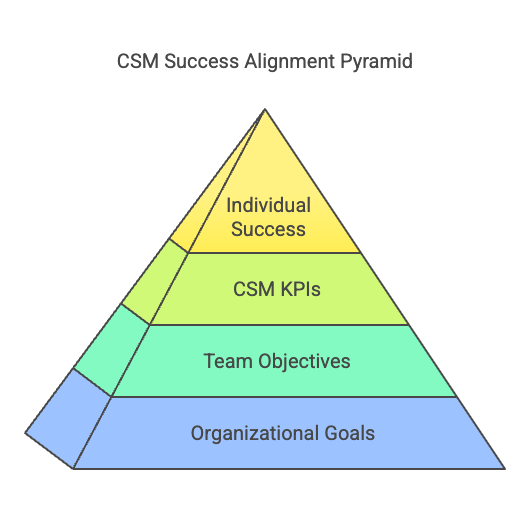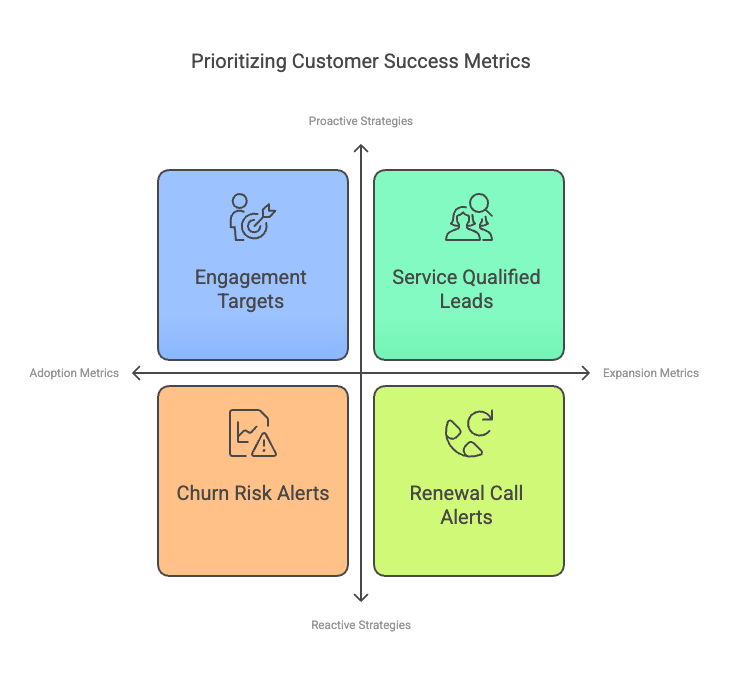7. Aligning CSM KPIs with Organizational Goals
Introduction:
In SaaS companies, aligning CSM Key Performance Indicators (KPIs) with organizational goals ensures that every individual contributor (IC) understands their role in driving the company’s success. As we discussed earlier in the context of strategic planning and budgeting, company-wide objectives established at a high level are cascaded across teams, regions, and segments, eventually translating into specific targets for ICs. This alignment ensures that every CSM knows what is expected of them and how their success contributes to achieving the company’s overarching goals.
For a CSM, this means being assigned a balanced mix of leading and lagging indicators that cover core responsibilities—adoption, engagement, retention, and expansion. These KPIs not only measure success but also provide a clear roadmap for how their actions contribute to company outcomes.

1. Leading Indicators: Proactive Metrics for Driving Success
Leading indicators measure proactive activities that predict future outcomes. They are closely tied to a CSM’s day-to-day responsibilities and focus on engagement and opportunity generation.
Adoption Metrics: Driving Product Utilization
- Engagement Targets: CSMs may have a target for a specific number of customer calls or meetings per month. These interactions help customers realize the value of the product, ensuring consistent adoption.
- Coverage Goals: To ensure balanced attention across their book of business, CSMs are required to engage with a defined percentage of their accounts monthly. This prevents over-servicing certain segments while under-serving others.
Expansion Metrics: Growing the Customer Relationship
- Service Qualified Leads (SQL): CSMs are often tasked with uncovering opportunities to expand the customer’s usage by identifying needs for new products or services during regular engagements. For example:
- A CSM identifies five SQLs in a quarter, passing them to Sales for deeper discovery.
- These SQLs result in additional ARR, contributing to a target such as generating $50,000 ARR from expansions in a year.
Proactive Alerts and Lifecycle Touchpoints
- Renewal Call Alerts: For example, initiating a renewal conversation 90 days prior to contract expiration ensures that potential risks are addressed early.
- Churn Risk Alerts: Systems may flag accounts showing declining usage or engagement, prompting the CSM to intervene and mitigate churn risks.

2. Lagging Indicators: Measuring Business Outcomes
Lagging indicators measure the outcomes of past actions and are often tied to the company’s north star metrics, such as ARR and retention. These metrics reflect the overall health and performance of the CSM’s book of business.
Retention Metrics: Ensuring Predictable Revenue
- ARR Retention: CSMs are tasked with retaining a specific percentage of their book of business over a period (e.g., 90% ARR retention annually). While the actual retention metric is determined at the end of the period, quarterly or monthly breakdowns help track progress and allow for mid-course corrections.
Churn Prevention and Risk Management:
- Churn Rate Targets: Minimizing churn is a core goal, and targets often focus on ensuring a churn rate below a certain percentage, such as <5%.
- Closed Alerts: Metrics may track the number of risk alerts successfully resolved, ensuring timely action on potential churn or renewal risks.
3. Mastering Performance Forecasting and Continuous Improvement
To excel in their role, CSMs must master the ability to forecast their performance against assigned KPIs. This requires consistent reflection on Year-to-Date (YTD) progress, identifying strengths and areas for improvement, and taking corrective action where necessary.
Key Practices for Performance Forecasting:
- 1:1 Meetings with Managers: Use these sessions to review performance metrics, discuss progress toward targets, and strategize on areas needing improvement.
- Reflective Analysis: Regularly assess what is going well and where interventions are needed. For example, if a churn alert resolution rate is low, prioritize additional customer engagement training.
4. Linking KPIs to Compensation and Growth
CSMs should recognize that their performance against these KPIs directly influences their annual performance reviews and any variable compensation tied to their role. High performance on both leading and lagging indicators not only supports company goals but also opens opportunities for career growth and financial rewards.
Key Takeaways for CSMs:
- Balance Leading and Lagging Metrics: Understand that proactive engagement metrics (e.g., calls, SQLs) are just as critical as outcomes like ARR retention.
- Reflect and Improve: Use 1:1s and self-assessments to stay on top of targets and address gaps early.
- Focus on the Bigger Picture: Your contributions in adoption, retention, and expansion directly impact the company’s financial performance and long-term success.